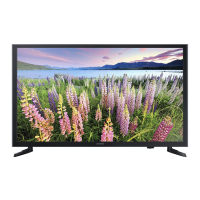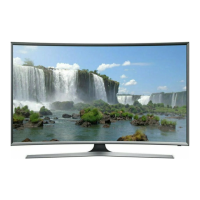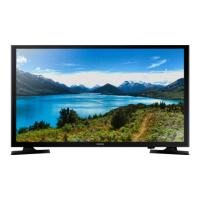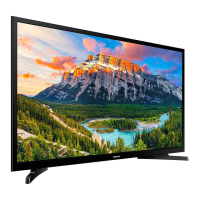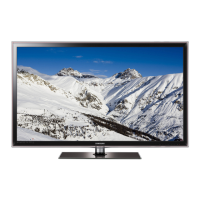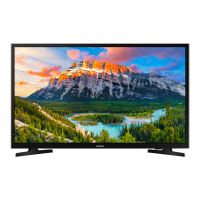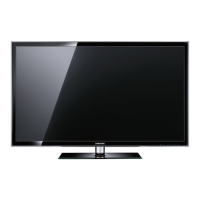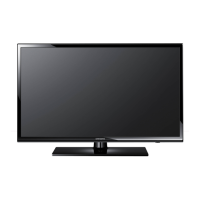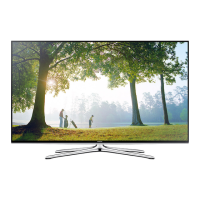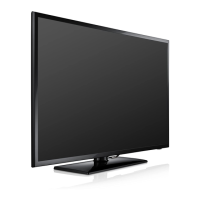Do you have a question about the Samsung UN32J5205AFXZA and is the answer not in the manual?
Connects various external video devices to the TV for input.
Connects audio receivers via an optical cable for digital audio output.
Instructions for using the TV as a computer display via HDMI or DVI cables.
Connects a computer to the TV using an HDMI cable for display.
Connects a computer with a DVI port to the TV using a DVI to HDMI cable.
Accesses media files on a computer over a home network.
Wirelessly displays the mobile device's screen on the TV.
Connects mobile devices directly to the TV without a router using Wi-Fi Direct.
Accesses media files on a mobile device over a home network.
Additional options like editing names and viewing information for connected sources.
Steps to connect and use a USB keyboard for TV control.
Steps to connect and use a USB mouse for TV control.
Explains features like Recommended text and Text Prediction for easier text input.
Recommends Cat 7 LAN cables for linking the TV to Internet Access Points.
Guides to automatically connect the TV to a wired network.
Steps to manually configure IP settings for a wired internet connection.
Guides to automatically connect the TV to a wireless network via SSID and password.
Steps to manually configure IP settings for a wireless internet connection.
Solutions for common problems with wired internet connections.
Solutions for common problems with wireless internet connections.
How to diagnose and resolve issues with the Smart Hub connection.
Accesses the main screen of Smart Hub for browsing apps, channels, and sources.
Step-by-step guide to creating a Samsung account for Smart Hub services.
Procedures for logging into an existing Samsung account on the TV.
Connects external service accounts (e.g., Facebook) to your Samsung account for integrated access.
Instructions on how to download and install applications from the SAMSUNG APPS store.
How to access and navigate the TV's embedded electronic manual.
Explains different ways to browse the web, such as Pointer and Link Browsing.
Features to limit access to specific web pages, often used for parental controls.
Process for removing installed applications from the TV.
How to play media files stored on a USB device connected to the TV.
Plays media content stored on computers or mobile devices via network connection.
Controls for pause, play, rewind, fast forward, and settings during video playback.
Controls for pause, play, rewind, fast forward, and repeat modes during music playback.
Accessing and using the TV guide to view program lineups and schedules.
How to schedule TV programs for automatic viewing using the guide.
How to schedule TV programs for automatic viewing for analog channels.
Options within the channel list, such as sorting by genre or editing favorites.
Procedures for managing the TV's channel list, including adding and deleting channels.
Modifies existing registered channels, such as renaming or editing favorites.
Setting parental controls to block programs based on their age or content ratings.
Steps to add frequently watched channels to a personalized favorites list.
Optimizes picture and sound settings for sports viewing.
Options for choosing the language for TV broadcast captions.
Activates or deactivates the Picture-in-Picture feature.
How to select the preferred audio language for TV broadcasts.
Removes scrambled channels from the auto-programmed list.
Explains various picture modes and their suitability for different environments.
Automatically adjusts screen contrast for optimal viewing.
Watch TV broadcasts and external device content simultaneously in a picture-in-picture format.
Adjusts the display size of programs and videos to fit the screen.
Selects sound modes optimized for different viewing and listening circumstances.
Options to choose where audio output is directed, such as TV speakers or external receivers.
Manually or automatically sets the TV's clock.
Sets the TV to automatically turn off after a specified period.
Configures scheduled times for the TV to turn on automatically.
Protects the screen from after-images caused by static images.
Enables control of HDMI-CEC compatible devices using the TV remote.
Provides options to update TV software via internet, USB, or auto-update.
Steps to update TV software by downloading from the internet.
Steps to update TV software using a USB flash drive.
Scans the TV and connected media for malicious code.
Sets a PIN for security, channel locking, and settings changes.
Allows Samsung technicians to diagnose and repair the TV remotely.
Allows users to request service support directly from the TV.
Uses a test pattern to diagnose picture issues and determine if the TV or external device is at fault.
Addresses sporadic flickering or dimming of the TV screen.
Troubleshoots issues related to the TV not powering on correctly.
Checks for sound problems by playing a test melody and verifying connections.
Troubleshooting steps when the TV fails to tune into all available channels.
Addresses issues where the computer's resolution is not compatible with the TV.
Solutions for problems with connecting to a wireless network.
Explains how app language is determined and how to change it if possible.
Addresses potential playback issues with high-bitrate media files.
Resets most TV settings to factory defaults, excluding network configurations.
Troubleshoots black bars on the screen due to aspect ratio or upscaled content.
Details supported wireless security protocols like WEP, WPAPSK, and WPA2PSK.
Lists supported resolutions for LED 5 and 6 series TVs when connecting a computer.
Lists supported resolutions for IBM compatible computer connections.
Lists supported resolutions for MAC compatible computer connections.
| Screen Type | led |
|---|---|
| Wall Mount | 200mm x 200mm |
| Features | motion rate 60, wide color enhancer, connectshare movie |
| Tuner | digital |
| Screen Size | 31.5 inches, 32 inches |
| Refresh Rate | 60hz |
| Closed Captioning | yes |
| Motion Enhancement | motion rate 60 |
| HDR | no |
| Built-In Speakers | true, downward firing |
| Surround Sound | dts premium sound, dts studio sound, dts-hd, dolby digital plus |
| Speakers Output | 10 watts |
| USB Ports | 1 |
| USB 2.0 Ports | 1 |
| Ethernet | yes |
| RF Antenna | yes |
| Bluetooth | no |
| Network | built-in wi-fi |
| Headphones Output | no |
| Digital Optical Audio Outputs | 1 |
| Analog Audio Outputs | 1 |
| Component Video Inputs | 1 |
| Composite Video Inputs | 1 |
| DVI | 0 |
| SmartTV | samsung smart tv |
| Remote Control | smart |
| 3D | no |
| Power Consumption | 52 kilowatt hours |
| Depth with Stand | 5.7 inches |
| Height with Stand | 18.5 inches |
| Width with Stand | 29.2 inches |
| Net Weight with Stand | 8.6 pounds |
| Depth without Stand | 3.1 inches |
| Height without Stand | 17.2 inches |
| Net Weight without Stand | 8.4 pounds |
